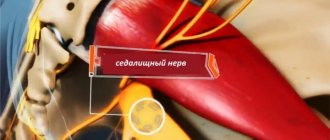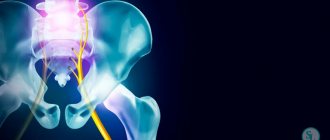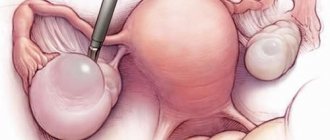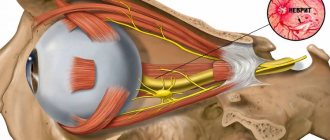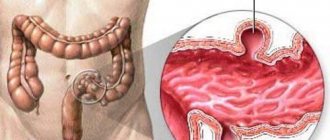The back and spine are important parts of the body. A person who feels pain in these areas is often unable to even lead a normal life, is forced to give up a number of physical activities, and has difficulty going to work. What can we say about favorite hobbies that you simply can’t do? Often the cause of pain in the lumbar back is a pinched sciatic nerve. How to treat this illness, how to help yourself in this situation and return to life without pain?
Pinched sciatic nerve - how to treat it
Symptoms and features of the disease
The sciatic nerve, which can sometimes cause a lot of problems, is considered the largest and longest nerve in the entire human body . It begins in the area of the lumbosacral plexus and then spreads along the lower extremities along the thighs. In the knee area, the nerve is divided into two smaller ones - the small and large tibia, the responsibility of which is to control the functioning of the feet. Its purpose is to execute CNS signals by a number of human organs and muscles.
Where is the sciatic nerve located?
Pinching of this nerve (or sciatica) can cause severe discomfort to a person, as it is accompanied by severe pain and often loss of ability to work. Pinching itself is a developing inflammatory process. And the resulting pain will be felt in the back and back of the thighs.
On a note! A pinched sciatic nerve often develops as a consequence of a number of other diseases. Although most often it occurs due to problems with the spine.
Pinched sciatic nerve
The symptoms of sciatica are quite striking, and the disease is difficult to confuse with any other. The main features are given in the table.
Table. Main symptoms of sciatica.
| Sign | Information |
| Severe pain | In fact, the intensity of pain can vary. It often depends directly on what was the main cause of sciatica, and can range from mild tingling to quite severe pain. Sometimes a person is not even able to move normally. Often pain is observed only on one side of the body, on the left or right. If a person does not move, then the pain will be felt insignificantly. But when changing body position, it intensifies. |
| Sensitivity problems | Nerve endings no longer react to any influence as they should. And there may be both a decrease in sensitivity and an increase in it. |
| Problems with gait and movement | This symptom is often called intermittent claudication, as it occurs periodically during attacks of pain. During movement, the pain becomes stronger and the person instinctively tries to walk in such a way that there is less load on the painful part of the body, that is, the main support goes to the leg in which the pain is felt less. |
| Tingling, numbness, burning | Typically, these signs are noted in the buttocks, feet, legs, and often in the toes. |
| Decreased mobility | Sciatica makes it harder and harder to move. Mobility in the back or knee joints especially worsens - bending and straightening your legs is painful and uncomfortable. |
How does sciatica manifest?
Also, people experiencing sciatica often note a loss of strength and are unable to perform any activities that lead to an exacerbation of pain. Sometimes the body begins to react sharply to a pinched nerve - the body temperature rises. But if this symptom appears, then under no circumstances should you hesitate to see a doctor. Especially if everything is accompanied by problems with urination or potency in men.
Inflammation
According to statistical indicators, in most cases, sciatica affects those who are already thirty years old. Every fourth person in the world experiences back pain. And every fifth case of such pain occurs due to inflammation of the sciatic nerve.
This pathology also has a shorter name - sciatica. He also has neuritis, sciatica, neuropathy. All these terms mean the same thing. By the way, this is not the disease itself, but only a syndrome - a signal from the body about diseases in the lower back and sacrum.
Causes
There are several reasons that cause pinching of the sciatic nerve. The occurrence of sciatica is often associated with the spine, which is not surprising - throughout life it experiences enormous stress. People work physically, carry heavy loads, do not watch their weight and lead a sedentary lifestyle. Without dosing the load and carrying out prevention, the condition of the spine worsens. So, among the causes of sciatica associated with the spine, we can highlight:
- osteochondrosis;
- inflammatory processes in the spinal column;
- intervertebral hernia;
- displacement of vertebral discs;
- spinal injury.
There are several possible causes of sciatica
Diabetes, hypothermia, any tumor processes, and radiculitis can also trigger the development of sciatica. The disease can also be caused by spasms of muscle fibers (usually piriformis syndrome), which can compress the nerve.
Important! To begin effective treatment for sciatica, it is important to identify the underlying cause. Only a doctor can do this by conducting a series of diagnostic studies. Otherwise, only the pain syndrome will be relieved, but the pain will return over time and, possibly, with greater severity.
How to treat it?
Only after determining the exact diagnosis and cause is treatment prescribed. As a rule, it is impossible to cope with sciatica at home, you can only alleviate the condition, therefore a visit to the clinic is necessary. Usually, the first step in treatment is pain relief. For this, various analgesic drugs are used. Compresses and bed rest may also be recommended. Injections are prescribed to relieve spasms. Injections can also be prescribed to relieve inflammation.
A number of physiotherapeutic treatment methods have shown themselves to be very effective. This could be massages, shock wave therapy, sessions with a chiropractor, gymnastics, UHF, reflexology.
Acupuncture
Attention! You should not limit yourself to taking painkillers. In this case, the disease will progress, and the person simply will not feel pain. It is important to strictly follow the doctor’s recommendations, only then will you be able to cope with sciatica.
If sciatica has developed against the background of some other disease, then even surgical treatment methods can be used. Most often they are used for intervertebral hernias. As for home treatment, during a visit to a doctor you should consult about the possibility of using a number of techniques. If there are no contraindications, then the following can help at home:
- massages, including cupping;
- use of anti-inflammatory ointments;
- various tinctures based on the gifts of nature, including pine buds, dandelions, etc.;
- wax applications (the main thing is not to burn the skin, since the wax is heated);
- gymnastics that can be done at home.
The use of anti-inflammatory ointments
By the way, it is gymnastics that often helps to quickly return to normal . Exercises such as walking on the buttocks, cycling, and stretching are especially useful. The main thing is to monitor your condition while performing exercises and if pain appears, you should immediately stop the gymnastics session.
Table. Drugs used to relieve pain.
| Name | Action |
| Diclofenac | To relieve pain, the drug is used in tablet or injection form. Relieves inflammation and pain. Only a doctor can prescribe a regimen for taking the drug, depending on how severe the pain syndrome is. You cannot prescribe it to yourself, as the drug has a lot of serious side effects and can be addictive. |
| Ketoprofen | Is a representative of the NSAID group. Quickly relieves pain and fever. Well and quickly absorbed. It is used in tablet form because it acts faster and more efficiently. If you use the drug externally, the effect will occur only after a few hours. |
| Ibuprofen | This is a non-steroidal anti-inflammatory drug that relieves swelling well and provides excellent pain relief. The effect lasts approximately 6-8 hours. It cannot be combined with other similar drugs. |
How to give an injection correctly
Among the ointments that are effective for sciatica are Finalgon, Viprosal, Nicoflex and Alisartron . They warm well, increase blood circulation, and improve tissue nutrition. To reduce pain, ointments Cel T and Traumeel S .
Our specialists
Tarasova Svetlana Vitalievna
Expert No. 1 in the treatment of headaches and migraines. Head of the Center for the Treatment of Pain and Multiple Sclerosis.
Cephalgologist.
Somnologist. Epileptologist. Botulinum therapist. The doctor is a neurologist of the highest category. Physiotherapist. Doctor of Medical Sciences.
Experience: 24 years.Derevianko Leonid Sergeevich
Head of the Center for Diagnostics and Treatment of Sleep Disorders.
The doctor is a neurologist of the highest category. Vertebrologist. Somnologist. Epileptologist. Botulinum therapist. Physiotherapist. Experience: 24 years.
Bezgina Elena Vladimirovna
The doctor is a neurologist of the highest category. Botulinum therapist. Physiotherapist. Ozone therapist Experience: 25 years.
Palagin Maxim Anatolievich
The doctor is a neurologist. Somnologist. Epileptologist. Botulinum therapist. Physiotherapist. Ozone therapist Experience: 7 years.
Mizonov Sergey Vladimirovich
The doctor is a neurologist. Chiropractor. Osteopath. Physiotherapist. Experience: 9 years.
Drozdova Lyubov Vladimirovna
The doctor is a neurologist of the first category. Vertebroneurologist. Ozone therapist. Physiotherapist. Experience: 18 years.
Zhuravleva Nadezhda Vladimirovna
Head of the center for diagnosis and treatment of myasthenia gravis.
The doctor is a neurologist of the first category. Physiotherapist. Ozone therapist Experience: 17 years.
A little about massages
If you combine various treatment methods with massage, you can achieve improvement quite quickly. The main thing is to first eliminate the pain, and then attend sessions with a massage therapist, since if there is discomfort, the desired effect will not be achieved.
It is important to choose the right massage therapist. He must have an appropriate document confirming the availability of the necessary skills. If the massage technique is incorrect, it can seriously harm your health.
Massotherapy
Usually the course of massages is quite long, but it needs to be completed completely to get the desired effect. As a rule, you will have to visit a massage therapist at least 10 times . Massage stimulates blood circulation, enhances tissue nutrition and helps release the sciatic nerve, and therefore improve the condition. Further, even after healing, it is necessary to periodically repeat the course to avoid relapses.
Exercises for sciatica
Gymnastics is an excellent therapeutic and preventive measure for pinched nerves. Let's look at the basic exercises recommended in this case.
Step 1. The plank will help straighten the shoulder girdle, spine, neck and hips. The main thing is that it is done correctly. To do this, you need to lie on the floor or mat face down, then focus on your toes and hands. In this case, it is important to place the elbows directly under the shoulder joints. The shoulder blades are pulled back, the stomach tenses. The hips should not sag, for this they will need to be tense. Next, having assumed the position, it is recommended to hold for 10 seconds or more. It is required to perform 3 approaches with a break of 30 seconds.
How to do the plank exercise
Step 2. Hip raises train the gluteal muscles well and correct the position of the pelvic bones. To perform them, you need to sit with support on the edge of the sofa or lie on the floor. You need to bend your knees and position your legs so that they are hip-width apart. Feet rest on the floor. The body needs to be lifted upward, as if pushing out the femoral part, and at this time the buttocks are brought together. Perform 3 sets of 10 repetitions. There is a 1 minute break between approaches.
Thigh lift
Step 3. The side plank works well on the abdominal muscles, which help the spine cope with the load on it. To perform the exercise, you need to lie on your side, lift your body with support on your elbow and try to straighten up. It is important to remain in this position for 10-30 seconds. 3 approaches are also performed. The exercise is repeated for the second side.
Side plank
Step 4. Another exercise is wall sliding. To perform it, you need to stand with your back to the wall, lightly touching it. The palms should be placed on the wall and slowly slide along it, trying to ensure that the hips are in a horizontal position. You should stay in this position for 5 seconds. The exercise is repeated 5 times.
Wall Sliding
Step 5. Next, leg lifts are performed from a supine position. First, one leg rises up, stays in the raised position for 5 seconds, then lowers, and the other leg takes its place. Requires 5 repetitions for each limb.
Leg Raise
Step 6. To perform the bridge, you will need to lie on your back, bend your knees and place your feet on the floor. Next, it is important to lift your back and buttocks off the floor, supporting yourself with your hands. You need to stay in this position for 5 seconds. 5 repetitions are performed.
Disease prevention
To prevent the development of lumboischialgia, it is recommended:
- eat rationally;
- move more often;
- exercise;
- perform exercises that strengthen the back muscles and stretch the muscles;
- when doing physical work, use the principles of biomechanics;
- balance the load with the body’s capabilities;
- fight excess weight;
- promptly treat diseases of the spine, blood vessels and digestive system;
- don't get too cold.
